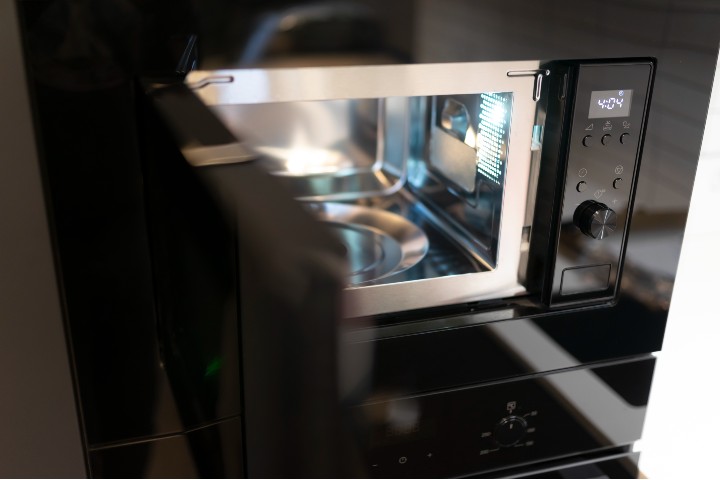Want to share feedback? Contact us.
Manufacturers have emphasized the importance of keeping your microwave door securely closed while cooking/reheating, but what about after?
Is it safe to leave the door open after use?
Here’s Whether You Should Leave Your Microwave Door Open After Using It:
Leaving the microwave door open for a short time after use lets the steam trapped inside to evaporate. This prevents condensation from leaving water marks on the oven walls and moisture buildup between the glass door layers. Airing it out for a few minutes also helps eliminate strong food smells.
If you cook or reheat something with high moisture content, like vegetables, the vapor can leave a puddle of water inside the microwave oven. This is normal, especially if you heat it up for a long time.
Letting the water dry on its own will leave stains that are often difficult to remove. Spillage in the microwave can also seep into the frame where the oven and the door meet.
When liquids and food harden and form a crust, the door may stop sealing correctly, allowing microwave energy to leak.
Wiping the mess down right away should do the trick and save you hours of cleaning time, but be careful of burns.

Sometimes, the vent fans of the microwave also get blocked, preventing moisture from escaping. When this happens, you should expect excess water to pool inside.
You can prevent this from happening by doing this simple trick.
After using the microwave, open the door for a while and let it cool. Then, use a damp rag or paper towel to wipe down the sides, top, bottom, and door of the inside of the oven.
You should also always keep the door gasket area clean. To remove stubborn spots, using a sponge dipped in vinegar and water solution gets the job done.
Getting any liquid or dirt in the vents will result in blockage, so you should be careful. They are often located on the bottom or sides of your appliance.
When you leave the microwave door open, it also helps in removing odors from the compartment.
Microwaves have the tendency to soak up the smells of the foods that you cook in them, especially if you do not do regular cleaning.
With light food smells, you can easily eliminate the odor by airing out the appliance after use. You can also use natural air fresheners like baking soda and charcoal.
With burnt smells, it is as simple as allowing your microwave to air-dry with the door open.
Much of the mix-up regarding the danger of keeping microwave doors open is about radiation. Many users are apprehensive about potential health hazards from exposure to microwave energy.
Microwaves use electromagnetic radiation for cooking food. Since they only use non-iodizing radiation, the food cooked in them does not turn radioactive.
The waves produced in the appliance then bounce off the oven walls and change to heat. The heat gets absorbed and targets the molecules in your food, causing them to vibrate.
The waves get to the outer layers first. When these portions are cooked, the inside gets done mainly due to heat conduction.
Manufacturers have warned against using an appliance with broken doors to avoid radiation exposure. However, a properly functioning oven should automatically turn off when you open the door.
Microwaves are designed so that electromagnetic radiation does not escape the oven compartment.
When you open the door, this automatically shuts off the magnetron, the high-power vacuum tube that creates the microwaves that heat your food.
If you leave your microwave door open, nothing will happen, except that the lightbulb will turn on if your appliance is still plugged in.
There is no fear of leftover radioactivity.
Microwave energy is only produced when the oven is operating. As soon as the appliance stops, it ceases to emit microwaves.
The last bits get absorbed quickly, within microseconds, long before you even open the microwave door.
Think of a room getting dark as soon as you turn off the light. This is the same speed microwaves disappear when you open the appliance door.
Moreover, microwave ovens have an interlock switch. The moment your microwave door locks, the latch connects to a switch. Once activated, this allows the appliance to receive power.
This mechanism ensures that the magnetron inside will only radiate microwave energy when the door is properly closed.
Microwave radiation-related injuries are not as common as you think. In fact, most injuries from microwaves are heat-related burns due to overheated food or liquids.
So if you are worried about radiation from escaping your microwave door when you open it for several minutes, do not. You should be safe enough from any exposure.
Having explained that, you should not let your microwave door gape longer than necessary. There are good reasons to close your microwave door after wiping it down.
If you leave the door open for too long and the oven is still plugged in, the light bulb will burn out faster.
While microwaves will work just fine with a broken bulb, you will want to replace them for convenience’s sake.
The light has no effect on the functions of your appliance, but it is helpful so you can see what is happening inside the microwave when it is operating.
Unless you use your microwave bulb as a nifty night light, you should close the door when it is not in use and save energy.
Another reason to keep your microwave door is to prevent accidents from happening. When it is open, there is a bigger chance of the door breaking when someone walks into it.
Aside from dealing with a nasty bump, you will probably need to have your appliance checked by a technician.
Issues with realignment due to a broken latch poses a serious risk. Broken door hinges can allow harmful microwave radiation to seep from your appliance.
If the microwave door is sagging and off its hinges, you need to have the broken joints firmly welded.
You should never do the realignment by yourself. Trying to weld parts of the safety system is just reckless. Let the professionals handle it for you.
Sources:
